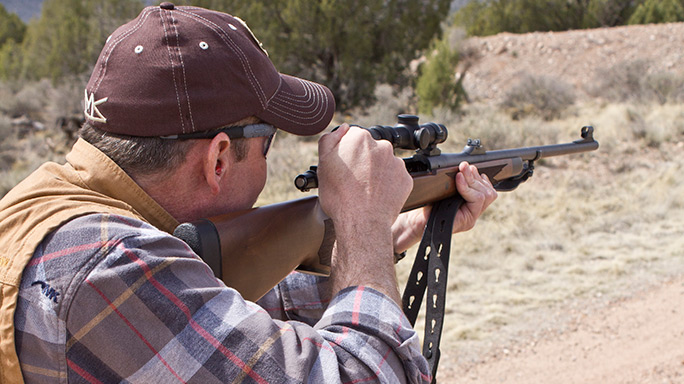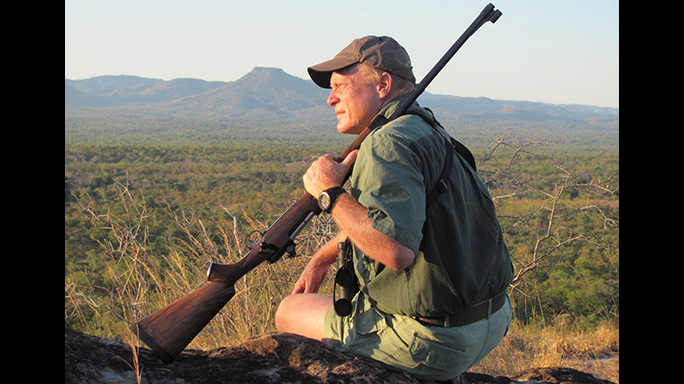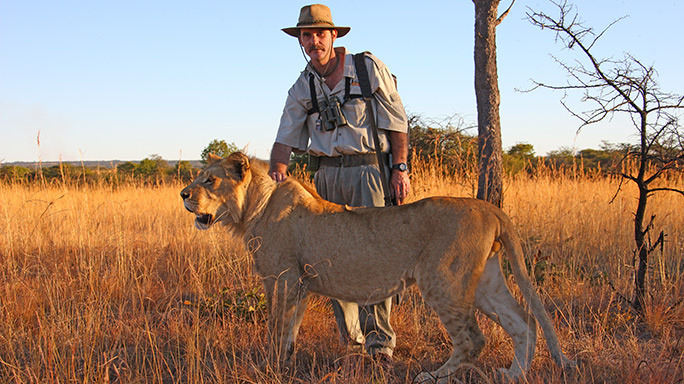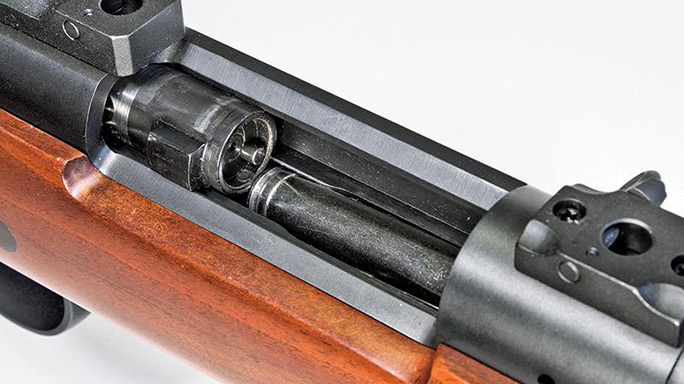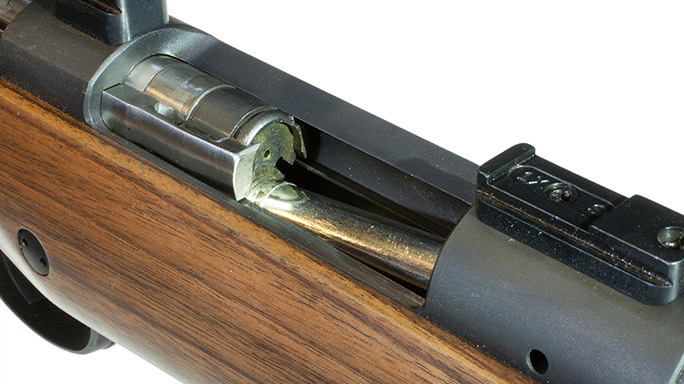One of the longest-running rifle debates is the controlled-round feed (CRF) versus push feed (PF) argument, which is primarily focused on rifles for dangerous game. Conventional wisdom dictates that when a fellow is confronted with a critter that might stomp him into a blood puddle, rifle reliability is paramount. Some believe this is best achieved with a CRF action, while others declare a PF action is soundly sufficient.
You should understand the difference. CRF actions control the cartridge from the time it leaves the magazine until it is ejected. As the bolt pushes the cartridge out of the magazine box, the extractor hooks the rim of the cartridge and “controls” it. If you partially chamber a cartridge with a CRF action and then pull the bolt all the way to the rear, the cartridge will be ejected. With a PF action, the cartridge is pushed into the chamber from the magazine. The extractor on the bolt does not engage the rim of the cartridge until the bolt is completely shut and the handle rotated down. If you partially chamber a cartridge in a PF action and then pull the bolt to the rear, the cartridge will remain partially chambered.
Double Feeds
Advertisement — Continue Reading Below
If you do not fully close the action on a PF rifle and attempt to cycle the bolt a second time, you may very well induce what is known as a “double feed.” A double feed is where you have one cartridge in the chamber and another trying to get there. No matter how you look at this situation, it’s not good if a lion is headed your way with a grin.
Some folks call this “short stroking.” I don’t think that’s the correct term. It’s actually a failure to fully cycle. Short stroking is when you do not pull the bolt all the way to the rear before attempting to close it. Failing to fully cycle a bolt is when you open it, pull it all the way to the rear but then fail to close it completely before you pull it to the rear again.
If you short stoke a PF action with a plunger ejector, you will not induce a double feed because the cartridge case will be ejected from the rifle before the bolt travels to the rear far enough to get behind the rim of the cartridge in the top of the magazine box. However, if you fail to fully cycle a PF action you can create a double feed.
Advertisement — Continue Reading Below
- RELATED STORY: Affordable & Effective: 16 AR-15 Rifles For Under $1,000
On the contrary, it is possible to retract a bolt far enough on a CRF action so that it clears the rim of the top cartridge in the magazine box prior to the cartridge that is being extracted being ejected. This is primarily because CRF actions use fixed ejectors that impact the rear of the cartridge being extracted. The amount of force with which you work the bolt determines how hard and how far the cartridge will be ejected. If you short stroke the bolt on a CRF action to the point where the face of the bolt has cleared the top cartridge in the magazine but has not been pulled to the rear far enough for the fixed ejector to do its job, when you shove the bolt forward you will induce a double feed. A double feed beyond Peter Hathaway Capstick’s ability to eloquently describe.
Hard-kicking dangerous game rifles exaggerate the circumstances that can lead to a double feed with CRF actions. During recoil, the cartridges in the magazine box can slip forward. This increases the distance between the rim of these cartridges and the fixed ejector. The result is the stroke necessary to induce a double feed becomes shorter.
Extractors & Ejectors
Advertisement — Continue Reading Below
Another facet of this argument centers on the extractors. PF rifles either utilize a C-shaped spring extractor, as on a Remington 700, or what is often referred to as a Sako or M16-style extractor, like on Howa or Weatherby actions. CRF actions like the Winchester Model 70 and Kimber use a long piece of spring steel that runs the length of the bolt. It’s difficult to look at these extractors without assuming the CRF extractor is stronger; it’s much more robust.
But, just how strong does your extractor need to be? Do you want it strong enough to pull the rim off of a stuck case? I’ve had to beat bolt handles open on both CRF and PF actions because of overpressure cartridges due to heavy loads or excessive heat.
And what if your extractor breaks? This can happen with both actions. The flange of the extractor that bites the rim is thin by nature. Sako and M16-style extractors are easy to replace in the field. Extractors on magnum Remington 700s and CRF actions? Not so much. Actually, some serious dangerous game hunters that rely on CRF actions carry a fitted extractor with them.
Advertisement — Continue Reading Below
The ejector plays a part in this drama, too. A spring-loaded ejector like that of a Remington 700 is what protects the action from double feeds as a result of short stroking. This is because the spring-loaded ejector ejects the cartridge—fired or unfired—as soon as the front of the cartridge clears the ejection port, regardless of how hard you work the bolt. Plunger ejectors can potentially fail by getting stuck in the bolt face due to dirt or brass particles, or even from overpressure loads.
Fixed ejectors rarely, if ever, break. Most are stout and firmly mounted to the action. The downside to the fixed ejector we have already touched on. To allow for positive ejection of loaded cartridges, they are positioned behind the rear of the rim of the cartridge in the magazine box. And the force of cartridge ejection is proportional to the force with which the bolt is pulled to the rear.
These are not the only ways that jams, stoppages or malfunctions can occur with either action. Geometric differences between different cartridges in improperly tuned actions can be problematic. And the unfathomably weird things humans are capable of doing with mechanical devices can induce unimaginable problems. One major difference does exist between a PF and a CRF action: If a PF action is empty, you can drop a loaded round in the ejection port and close the bolt. With a CRF action you will have to insert the cartridge into the magazine box for it to feed. Holding an empty rifle and facing a buffalo coming at me like a locomotive, I’d choose the PF action.
Advertisement — Continue Reading Below
Dangerous Game
I must admit that my experience facing bad beasties with a firearm have mostly been in uniform and were in the presence of animals substantially more dangerous than those that walk on four legs. By the time you read this I’ll have gone on my first African dangerous game safari using a Marlin lever action in .45-70. I share this is because I’m not the best source for field experience when it comes to dangerous game rifles.
My friend Craig Boddington is. If you were to go to Africa twice a year for the rest of your life, you’d die before you could equal Boddington’s number of safaris. This is partly due to the fact that his total is currently over 100 and partly due to the fact that he is not done yet. This is exactly why I asked Craig’s opinion.
Advertisement — Continue Reading Below
Craig said, “All things being equal, I do prefer CRF [actions] just as a small and mostly theoretical bit of personal confidence, especially in larger-caliber rifles that might be used for dangerous game. In practice, however, I’m a lefty. Until very recently there were almost no left-hand CRF actions, and even today lefty actions that are CRF tend to be a lot pricier than PF left-hand actions. Until 1980, most of my bolt-actions were right-handed, and they were a mix of CRF and PF actions. Back then I hardly knew the difference!”
Continuing, Craig said, “So I think that the actual difference in reliability is much more theoretical than practical. Today, with a much greater selection in left-hand actions, I have a mix, with a few rifles of larger caliber now CRF in a left-hand action. But, I have absolutely no qualms about using a PF in any hunting application. The only stipulation is that the rifle has to work, and this is something that must be determined on the range, practicing with a full magazine, long before you go hunting.”
PRIORITY #1
Advertisement — Continue Reading Below
Experience, undeniably, is the best teacher, and Don Heath, Norma Precision AB is Marketing Specialist, is another who has “seen the elephant.” Literally! Don’s faced multitudes of dangerous situations as a soldier and hunter. He also purveyed over the Zimbabwe professional hunter’s examination for some time, where he got to see a lot of guns work. And fail.
I asked Heath his opinion. “Many years ago, I wrote an article extolling the necessity of having controlled feed on a dangerous game rifle. Shortly afterwards, I got shot in the right shoulder and had to shoot left-handed for nearly 18 months. I bought a Winchester 70 and used it fairly extensively. It then struck me how many elephant and buffalo I had shot on problem-animal control duties with my issued FN FAL, which is of course a push feed.”
- RELATED STORY: Elite Ammo: G2 Research’s .223 Ripout ‘Trident’ Round
Don went on to say, “I have seen many, many controlled-feed weapons jam. I have seen many push-feed rifles function 100-percent fine.”
Advertisement — Continue Reading Below
Summarizing, Don added, “At the end of the day, the feed mechanism is irrelevant, provided that the rifle is 100-percent reliable in both feeding and ejecting under all conditions. The three requirements for a dangerous game rifle are reliability, reliability and reliability.”
It’s my opinion that the CRF versus PF debate is wasted air. Having a rifle that works, working it properly under stress and feeding it quality ammunition is much more important. Being able to shoot repetitively with speed and accuracy is important, too. This is something you can definitely work on and improve.
For more information on Norma, please visit norma.cc or norma-usa.com.
